
If there was ever a storyline I expected to see in Transmetropolitan, this is it! I’m guessing many of you have seen the USA Today special on the illegal selling of human body parts. You take your dead gramps to be cream-mated, and you get ashes alright, but they aren’t his. Instead, the crematorium or their employees have carved up his body and has cleared many thousands for selling all of his parts (hands, head, shoulder, eyes, legs, etc.) and organs (liver, brain, heart, lungs, etc.). Lest you think a regular burial prevents this outcome, you better check gramps’ insides before you lower the coffin - his brain may already be on its way to your favorite research facility by then!
Trafficking in body parts illegally harvested from the dead is a lucrative, underground business driven by growing demand for human bones and tissue, a USA TODAY investigation has found…Funeral home employees, crematorium operators and others with access to the recently deceased have secretly dismembered corpses, taking non-organ body parts such as knees, spines, bone and skin without the knowledge or consent of family members….
…Modern-day body snatchers provide bones, tendons and body parts other than transplantable organs to tissue banks, research facilities and other buyers. What they get paid: $600 for a brain, as much as $850 for an elbow, up to $850 for a hand, according to an analysis of market prices for fresh or frozen body parts used for research and education that was compiled by Annie Cheney, author of Body Brokers: Inside America’s Underground Trade in Human Remains.
Demand for tissue is growing. More than 19,000 square feet of skin were distributed in 2003 for transplant from accredited tissue banks, according to the American Association of Tissue Banks (AATB), up from 7,700 square feet in 1999. About 3,300 heart valves were distributed in 2003, up from 1,300 in 1999. Tumors and excess tissue that were once incinerated as waste can now be probed for DNA markers to help doctors understand disease.
Sometimes this business is enacted by individuals looking to make a buck, but more disturbing is the trend where the crematorium and other organizations themselves do this as their normal course of business.
If nothing else, this trend points to a further decay in the former “sacredness” of humanity. As we move toward a post-human, cyberpunked world, the perception of “uniqueness” each of us imagines we as individuals have begins to wear off. Moral boundaries are weakened, and behaviors previously thought taboo become commonplace. Welcome to the new world!
This post has been filed under Cyberpunked living by SFAM.

Researchers at the Florida Institute for Human and Machine Cognition have been experimenting with using a tongue as the “brainport” conduit for connecting cyborg-like implants. Their test subjects are soldiers, with the hope being that they can give soliders an edge in the battlefield.
By routing signals from helmet-mounted cameras, sonar and other equipment through the tongue to the brain, they hope to give elite soldiers superhuman senses similar to owls, snakes and fish.
Researchers at the Florida Institute for Human and Machine Cognition envision their work giving Army Rangers 360-degree unobstructed vision at night and allowing Navy SEALs to sense sonar in their heads while maintaining normal vision underwater turning sci-fi into reality.
The device, known as “Brain Port,” was pioneered more than 30 years ago by Dr. Paul Bach-y-Rita, a University of Wisconsin neuroscientist. Bach-y-Rita began routing images from a camera through electrodes taped to people’s backs and later discovered the tongue was a superior transmitter.
A narrow strip of red plastic connects the Brain Port to the tongue where 144 microelectrodes transmit information through nerve fibers to the brain. Instead of holding and looking at compasses and bluky-hand-held sonar devices, the divers can processes the information through their tongues, said Dr. Anil Raj, the project’s lead scientist.
Really interesting is the question of how humans treat this extra-perceptual capabilities. Will they eventually think of it as similar to their real senses, or will this be similar to wearing a pair of sun glasses or something? The wierd one to me is the eyesight enhancers:
Work on the infrared-tongue vision for Army Rangers isn’t as far along. But (lead scientist) Raj said the potential usefulness of the night vision technology is tremendous. It would allow soldiers to work in the dark without cumbersome night-vision goggles and to “see out the back of their heads,” he said.
How will soldiers function when they have 360 degree vision capability? At first glance, this seems like it could have some significant usability issues. In a rapid-response threat environment, will the extended vision aid in extending their situational awareness or could it potentially freeze them by incorporating too much input at a moment of high stress?
This post has been filed under News as Cyberpunk by SFAM.
Movie Review By: SFAM
Year: 1997
Directed by: Luc Besson
Written by: Luc Besson & Robert Mark Kamen
IMDB Reference
Degree of Cyberpunk Visuals: High
Correlation to Cyberpunk Themes: Low
Key Cast Members:
Korben Dallas: Bruce Willis
Leeloo: Milla Jovovich
Jean-Baptiste Emanuel Zorg: Gary Oldman
Father Vito Cornelius: Ian Holm
Ruby Rhod: Chris Tucker
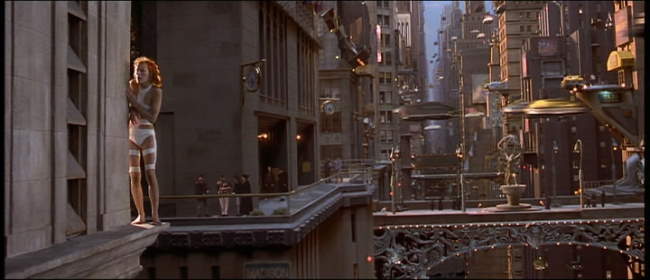
Overview: Some movies are just absolute absurd fun – so fun that you end up watching it endlessly. The Fifth Element is that way for me, and is a movie I’ve seen around 20 times or so. The tone of the movie is too light-hearted to be considered a real cyberpunk movie, but like Tank Girl, we can consider this a cyberpunk comedy. The characters are all a hoot, and the movie never takes itself seriously – in fact it’s almost always over the top. Many of the cyberpunk themes still exist in Fifth Element, although, again, they are enacted in a light-hearted way. It’s the visuals that really bring Fifth Element into the cyberpunk subgenre.
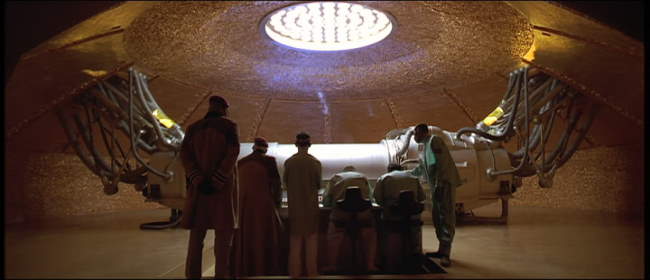
The Story: 217 years into the future, ultimate evil is again coming to destroy the earth. Ultimate evil takes the form of an absolutely massive malevolent ball of blackness that is on a course to destroy earth. Every attack the Federated Territories try only makes it larger. It turns out that a group of priests has been keeping the ancient technology necessary to destroy ultimate evil – four stones representing the 4 elements, which surround a fifth element. In this case, the fifth element is s beautiful girl (Milla Jovovich), reconstructed from the remains of a small DNA sample.
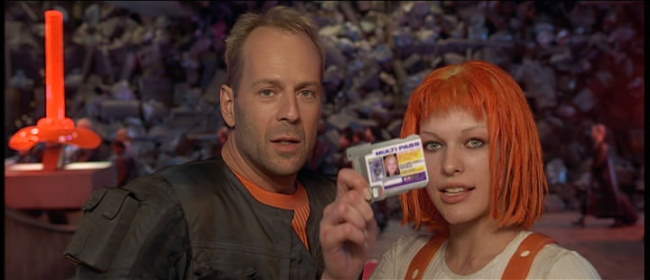
“Leeloo Dallas, Multi Pass”
Korben Dallas (Bruce Willis) is a down and out highly decorated former military commando, now turned failing cabbie, who has a beautiful girl named Leeloo (Jovovich) fall into her cab – literally! The authorities are after her, as it turns out she has escaped those who recreated her. She can’t speak English yet she figures a way to ask for help. After she asks, Korben Dallas takes her to the priest, Father Vito Cornelius, who recognizes her as the Fifth Element, and promptly kicks Korben out.
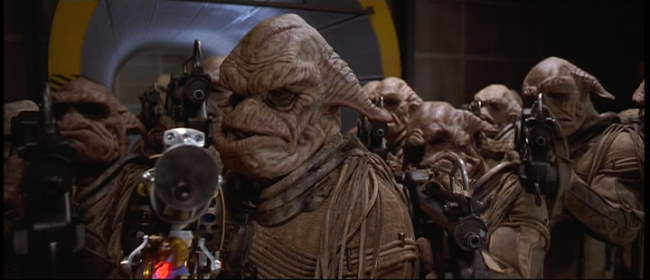
From there, things get crazy. The military approaches Korben for a secret mission to retrieve the stones necessary to stop ultimate evil. The stones are hidden with a famous Diva who is performing at the famous floating hotel, Floston Paradise. At the same time, Zorg, an evil corporate CEO (Gary Oldman) has hired a group of Mangalores (evil, ugly aliens) to retrieve the stones. Simultaneously, Father Vito Cornelius and Leeloo also find a way get to Floston Paradise to retrieve the stones. Things get even weirder when the famous radio host, Ruby Rhod (Chris Tucker), an outrageous guy with a penis-head hairdo hosts the Floston Paradise experience with Korben as his guest!
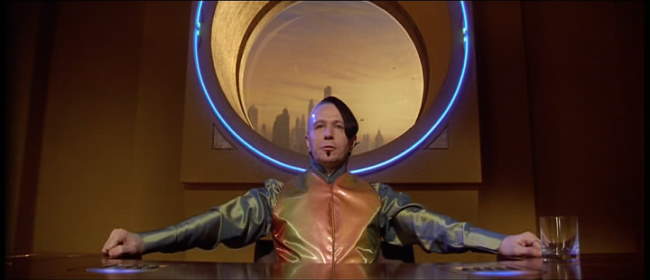
The Acting: All the main characters in the Fifth Element are quirky and memorable. Bruce Willis really works as a former hero, now on his last leg. Jovovich is beautiful and otherworldly. Tucker is a riot! This movie really got him known (Rush Hour made him famous though). And Gary Oldman as Zorg is flat out awesome as a completely crazed power-hungry evil doer with a quirky sense of style and salesmanship. Truly, Besson did a great job in casting this.
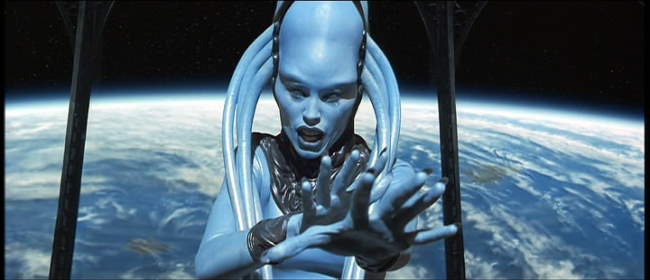
The Visuals: The Fifth Element totally rocks in the cool futuristic visuals department. The colors include dark yellows with neon blues for the backgrounds, saturated blue scenes and orange clothes for the leads. But its the city-scapes, reminiscent of Lang’s Metropolis that are especially memorable. They flat out nail a far out vision of the future. Additionally, we have airports with 30 foot tall trash heaps due to a garbage worker strike, fully automated, ultra-processed McDonalds, deaf rock stars
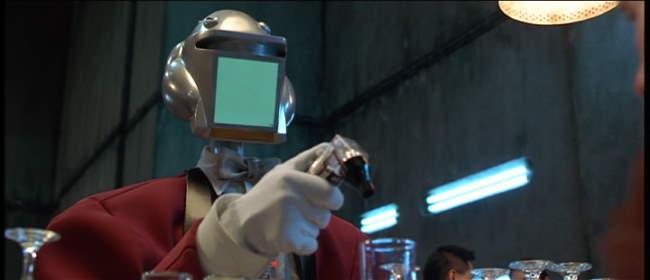
The Editing: The editing in the Fifth Element is just terrific. The splicing of the various story strands, as crazy as they are, flow wonderfully. In discussing the missing stones, the simultaneous, intermixed dialogue between Leeloo and Father Cornelius and Zorg with the Mangalores are just one terrific example of this; the Diva opera singling intermixed with Leeloo’s fighting is another. With the amount of stuff going on here, this could have ended up a disaster. Sylvie Landra, who also edited Leon – the Professional, deserves heaps of praise for this.
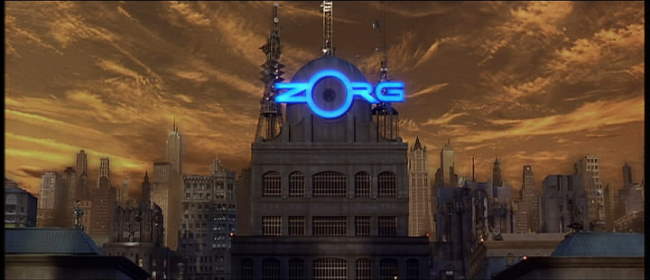
The Fifth Element Cyberpunked Future: Dropping the crazed fantasy aspects of the stones and ultimate evil, The Fifth Element gives us a pretty dire view of the future. Cities are built high to escape the constant layer of smog that coats the surface; corporations are all-powerful; governments are impotent; fashion statements have gone seriously awry; cockroaches are used as intelligence, surveillance and reconnaissance systems - but at least we still get cheap Chinese food! Plus robots now do all our menial work!
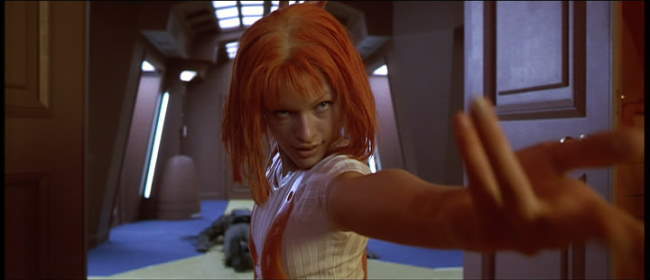
The Bottom Line: No, the Fifth Element is not intended to be taken seriously. Still, this movie is just far more enjoyable than it has any right to be. The action and romance are fun, the characters are unforgettable, the story is entertaining, the music is great, and the visuals are marvelous! The Fifth Element has been in my regular heavy watching rotation since it came out. Give this a watch if you’re looking for a witty futuristic cyberpunk action-comedy flick.
Go to Page 2: More Fifth Element Screencaps–>>
~See movies similar to this one~
Movie Review By: SFAM
Year: 1990
Directed by: Marianne Trench
IMDB Reference
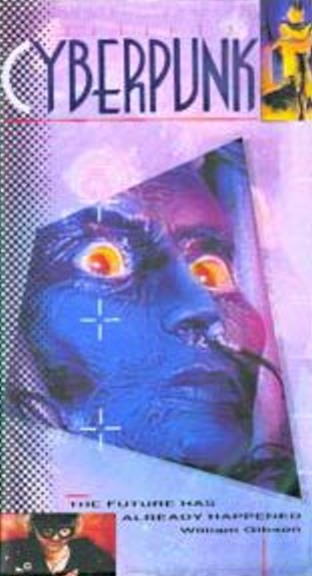
Overview: Cyberpunk is a documentary that looks back at the 80s cyberpunk movement, and more specifically, how this has led to a trend in the “real” world where people were starting to refer to themselves as “cyberpunk.” The documentary sees “cyberpunks” as being synonymous with hackers. A number of writers, artists, musicians and scientists are interviewed to provide context to this movement. The guiding meme, as told by Gibson, is that information “wants” to be free. 60s counter-culture drug philosopher, Timothy Leary, provides a prediction that cyberpunks will “decentralize knowledge,” which will serve to remove power from those “in power” and bring it back to the masses. Many different potential technologies are discussed, including “smart drugs,” sentient machines, advanced prosthetics – all of which serve to give context to the idea of post-humanity and its imminent arrival on the world stage.

As a documentary, Cyberpunk is haphazard. Some of the interviews, such as those by William Gibson and Timothy Leary are interesting, while others are mired in mediocrity. To mitigate the boredom of some of these, the film makers stoop to using cheesy visual effects to increase the interest. In one case, an interviewer is duplicated to four small windows, and in another, the talking head is completely moiréd out except for their eye. In fact, we are barraged by a stream of weird, experimental effects – one imagines that these are supposed to give us the “hacker-cyberpunk mindset” or something. In general, they don’t work, but I’m guessing the late 80s CG graphics probably looked far more futuristic back then.

The Bottom Line: This documentary really almost serves as a time capsule for capturing a still emerging hacker counter-culture. From a cinematic perspective, I’m saddened that Blade Runner was virtually non-existent in this. While they covered books, music (Front Line Assembly was the main one), science and art (Jaron Lanier, who coined the term “Virtual Reality”), their coverage of film was pretty sparse, generally restricted to obscure animes (which looked cyberpunk, but unfortunately I’m not familiar with). I will say I liked the younger William Gibson LOTS more than on his No Maps for These Territories documentary. He talks excitedly about cyberpunk, hackers, and our direction towards post-humananity. Ten years later, Gibson comes off completely bored with these ideas, and almost seems to wish he was never associated with the term, Cyberpunk.
~See movies similar to this one~
Movie Review By: SFAM
Year: 1996
Directed by: Jon Kroll
Written by: Mark Valenti
IMDB Reference
Degree of Cyberpunk Visuals: Low
Correlation to Cyberpunk Themes: Medium
Key Cast Members:
Menno: Bill Campbell
Loria: Stephanie Romanov
Mick Dourif, Rebel Leader: Bruce Campbell
Simon, Menno’s Friend: Michael Dorn
Felix Medina: Corbin Bernsen
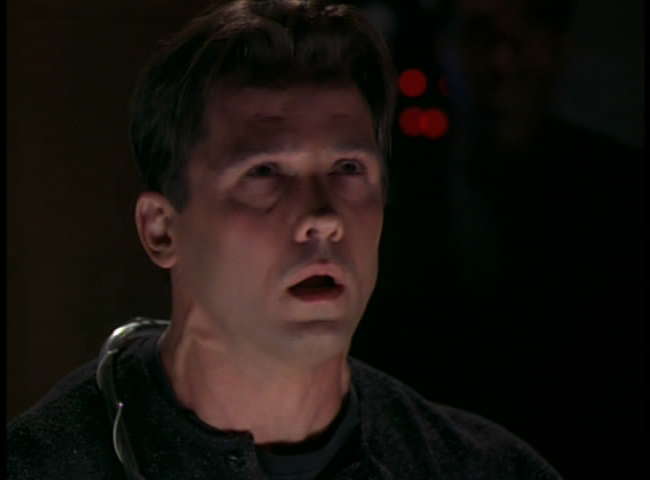
Overview: Here we have a movie with Bruce Campbell, Michael Dorn, and the very hawt Stephanie Romonov – this movie’s got to have something appealing, right? Um, not really. Menno’s Mind, a Showtime production is nowhere close to ready for prime time. The only thing worse than the acting and effects is the completely incoherent story. The FX are crappy low budget ones, but truly, nothing else in the movie even comes close to equaling them.
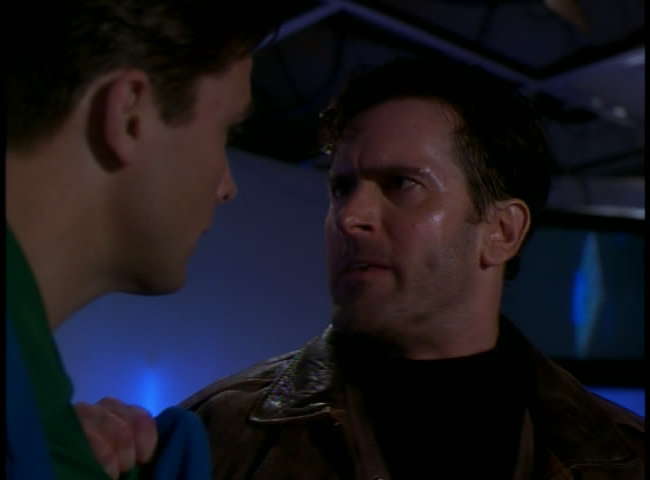
The Story: Menno’s mind takes place in a bizarre, cheesy future where everyone dresses in tacky bright clothes, except for the tough chicks, who wear black leather. Menno (The Rocketeer’s Bill Campbell) is a sappy computer programmer at a very popular virtual reality resort that provides people a choice of interesting vacations (most choose the virtual sex chick on the beach). The “System” that runs the VR vacations is very powerful, and has the capability to implant thoughts and suggestions into the vacationers. The resort’s head of security, Felix Medina (Corbin Bernsen), also happens to be running for President of the US (I shit you not…how far that office must have fallen for a head of security of a resort to be in the running!), and has decided to game the election by getting everyone who takes a vacation to be implanted with thoughts to vote for him in the election.
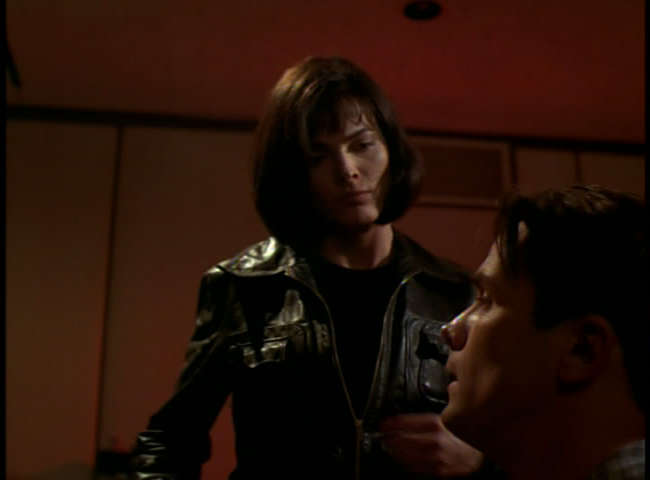
Luckily, disgruntled employee and rebel leader, Mick Dourif (Bruce Campbell), figures out the dastardly ploy and tries to stop it. Unfortunately, the bad guys have found him, and ambush his hideout. He barely escapes, goes to the VR resort, and forces Menno to upload his mind into the VR system before he dies! Yep, you heard it right, ladies and gents – although it wasn’t in the specs, apparently the VR system has the ability upload a human mind. Then things get interesting when Mick’s girlfriend, Loria, finds Menno and forces him to download Mick’s mind into himself in order to find out what Mick knew about the dastardly plot! From there, the race is on.
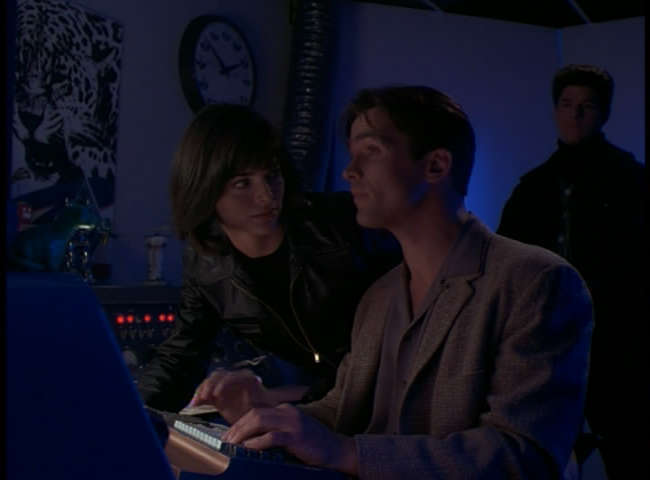
The Bottom Line: Truly, the number of problems and plot holes in this are almost uncountable. I’ll give it three stars because the production values are at least decent, but the story sucks more than words can describe. OK, so a security manager is running for President of the US – perhaps he should consider campaigning instead of trying to game a few hundred votes by convincing those who show up in the morning to vote for him – just a thought! I could go on, but the fairy science shown in this doesn’t even try to hold itself together. Worse, Bruce Campbell – really, the only reason I wanted to see this (I LOVE Army of Darkness!!!), dies early enough on that you barely get a chance to enjoy him.
~See movies similar to this one~

Simon from CyberpunkCafe posted a news item in the meatspace about this. Now Playing Magazine is reporting that William Gibson’s novel, Idoru, is going to be coming to anime. Alex Steyermark, a relative unknown has been given the reigns. Apparently, there was some discussion of turning this into a live-action movie but it was cost-prohibitive:
“The studio people that were reading the script all loved it,” Steyermark says. “They said, ‘This is a $150 million movie.’ One of them came back and said, ‘How would you feel about doing this as an anime film?’ I thought that is really cool, really creative. It’s exciting, it’s a great way to do it on a smaller budget. At the same time, [it] could set up a live action version of it.”
I am a bit concerned about this paragraph though. Apparently the entire story is not being implemented, and worse, they are planning for a sequel:
Steyermark’s script had to consolidate some of Gibson’s work, but don’t worry. He saved the rest for the sequel. “I played with the structure of the novel. The novel is done as two parallel stories and I focused on one. I actually am starting to work on the sequel which would sort of focus on the other. That’s how I thought I would approach it. People who were reading the initial drafts of the script said, ‘Look, you have to decide who it’s about. Is it the one or the other?’ So I did that kind of adaptation thing where you just shape it around one of the characters. But in my mind, everything that’s not in this one from the book, there are so many great things that will be from the book in the sequel.”
Hopefully, this will be handled well, but given the track record of Gibson book adaptations, there is certainly reason for concern. Pre-production may be getting underway as early as May, which still probably puts the movie to 2007 or 2008 at the latest.
This post has been filed under Upcoming Movies by SFAM.
Movie Review By: SFAM
Year: 2002
Directed by: Gary Fleder
Written by: Philip K. Dick (story), Scott Rosenberg (Adaptation), Caroline Case et a. (screenplay)
IMDB Reference
Degree of Cyberpunk Visuals: Medium
Correlation to Cyberpunk Themes: Medium
Key Cast Members:
Spencer Olham: Gary Sinise
Hathaway: Vincent D’Onofrio
Maya Olham: Madeleine Stowe
Cale: Mekhi Phifer
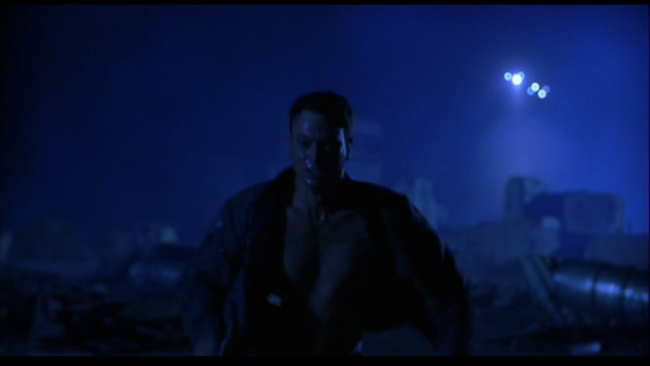
Overview: Impostor got bashed by critics for having bizarre cut always, too many slow motion scenes, and generally weird and herky-jerky cinematography decisions. Additionally, others criticize it due to originally being a 30-40 minute short that got extended into a full-length movie. While all true, I truly like both the story (basically the Fugitive, done in a near future setting) and the acting, especially by Gary Sinise and Madeleine Stowe. While the cinematography is definitely subpar in this Philip K. Dick story, the movie itself is still worth a watch.
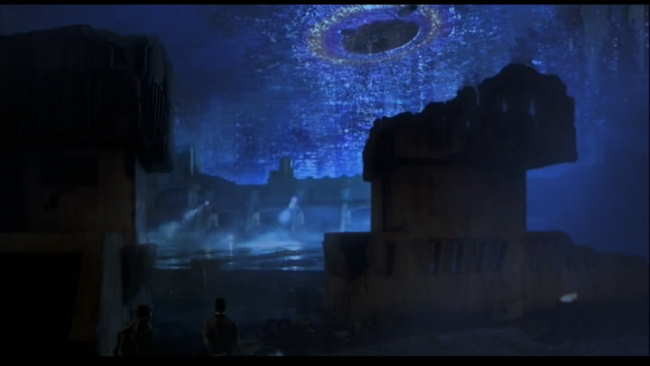
The Story: Impostor is set in the year 2079, a time when a race of aliens are attempting to invade the earth. To protect the population, humans now live in high-tech “bubbles” which seem to be able to keep out Alien weapon systems. Because of this, the aliens have resorted to creating DNA-based replicants, not unlike those in Battlestar Gallactica, by a process which apparently involves copying captured humans. These replicants are in actuality very powerful bombs, but have no self-awareness of being replicants – when their “trigger” is invoked (such as being in close proximity to their target), they explode.
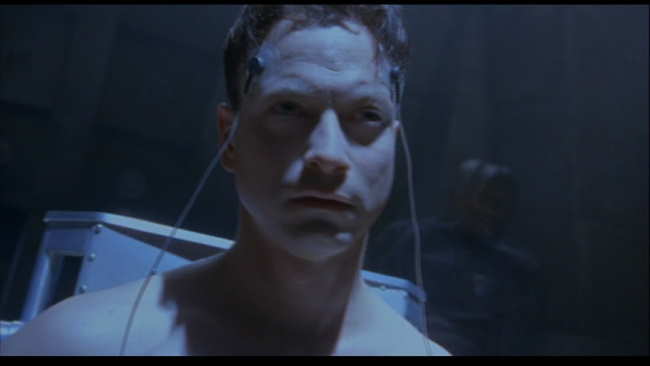
Sinise plays Spencer Olham, a weapons scientist who has been accused of being replaced by a replicant (called a cyborg in the movie). The security head (Vincent D’Onofrio) captures him and threatens to rip out his heart in order to prove that he’s not a human. Sinise escapes and then engages on a journey to prove his innocence. Olham determines that he can prove his innocence by equipment at the hospital where his wife (Madeleine Stowe) works, that compares a previous body scan with his current body. Unfortunately, he’s already gotten out of the city, and now needs to figure out how to get past security to return.
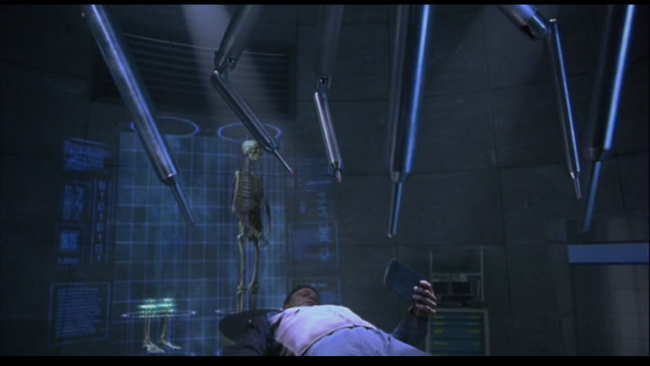
How Do You Know You’re You? This, in essence is the question Impostor is asking when it’s not in chase-filler mode. Is Spencer Olham a human caught in a horrid mistake, or is he a cyborg comprised of human-like bio-matter that is in actuality a powerful bomb sent by aliens to infiltrate Earth’s defenses in order to kill human leadership? If you were a cyborg-replicant imbued with the memories of the original host, how could you figure it out? Imposter briefly mentions the notion that the cyborgs don’t have a soul, but this is never pursued. One wishes they had come up with some way of quantifying a soul. But in the end, we are left to answer this question ourselves.
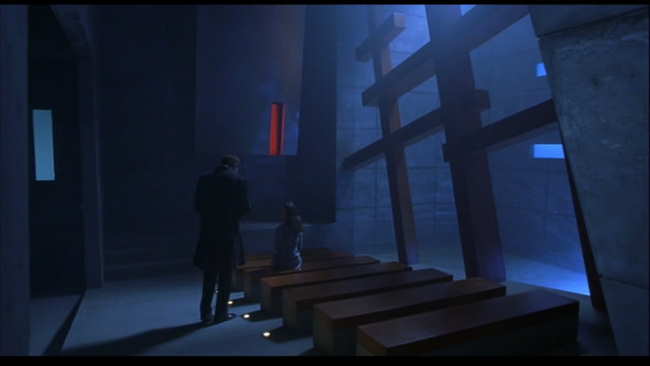
The Middle “Chase” scenes are Filler: Originally, Impostor was shot as a 30-40 minute movie short that was intended to be part of a larger collection. Apparently, Miramax liked the short enough (or cooled to the short collection idea) that they wanted it extended into a full length feature film. However, in doing so, they were left with a relatively tight beginning and tight end, and then a vast chasm of nothingness in the middle. By and large, the middle is filled with semi-pointless chase scenes that are sprinkled with people that aren’t germane to the central plot. Now we get a whole underground dystopia thing added to the mix, whereby it turns out that the nice hospital is ONLY for those who live in the bubble, while those in the outer area get little or no medicine and support. In its better moments, the middle part of the movie seems to want to emulate a “Fugitive” type feeling, but this doesn’t always work well. The DVD also includes the original movie short which is definitely worth a watch.
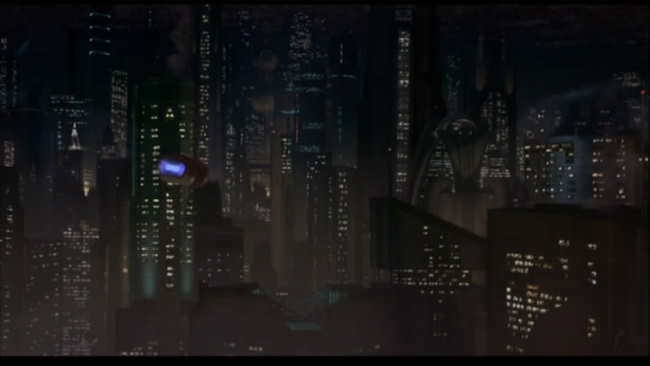
The Visuals: Impostor’s vision of the future is terrific in some places and haphazard in others. The cityscape scenes look right out of blade runner, the bubble city coverings, torture look great, but the majority of Imposter involves treks through regular looking tunnels. The torture equipment and medial imagine equipment are both more than passable. Imposter is strongly dominated by blue tones, which pervade most every aspect, from the chase scenes to the interrogation scenes.
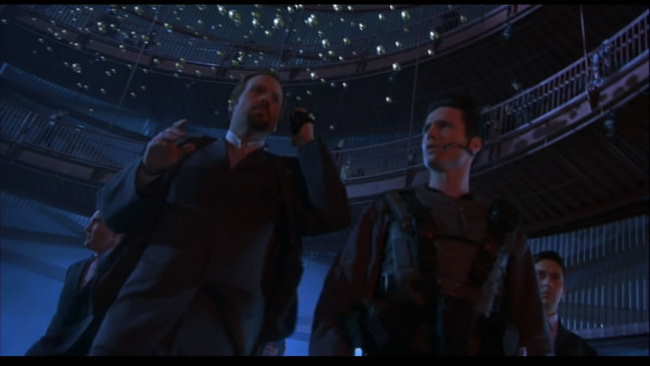
The Acting: By far, the best aspect of Impostor is the acting.Gary Sinise in particular really sells his role well, but Madeleine Stowe and Vincent D’Onofrio also give high quality performances, and Mekhi Phifer is at least passable. With slightly worse performances, Imposter could have easily ended up in the cheesy “B” Movie bin. The effects are uneven enough (some looked great, others looked TV-ish) that solid acting was a must to keep this movie watchable.
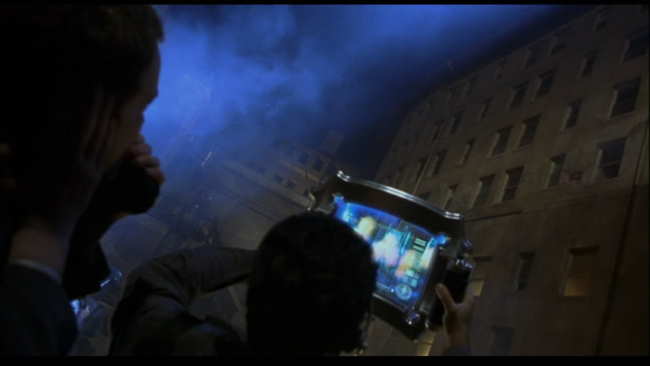
The Editing: Impostor is rightly criticized for crazy and continuous cut-shots. Rare is the shot that lasts more than 4 to 5 seconds before cutting to another view. The goal was to add to the tension of the chase scene, but the editors went overboard. Especially when combined with some strange shot angles, Imposter almost takes on an experimental vibe, as if they weren’t sure what would work, so they tried various different things.
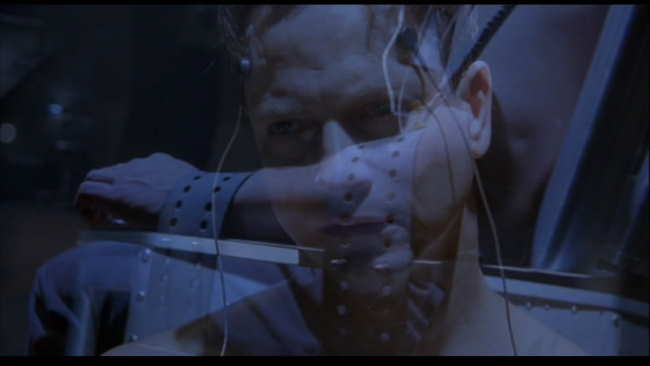
The Bottom Line: While this “Fugitive-like” movie has lots of interesting scenes, it’s the ending that I really like - definitely a cool twist. The acting is solid and the visuals are sometimes, but not always, pretty decent. There are lots of pointless tunnel-running that easily could have been cut by 15-20 minutes, and also, there are enough questions and plot holes that stop Imposter from being a great movie. Still, the question of determining humanity is an interesting one, and is well executed.
~See movies similar to this one~
Author: Warren Ellis (writer) & Darick Robertson (Artwork)
Year: 1997-2003
Category: Graphic Novel
Publisher: Vertigo
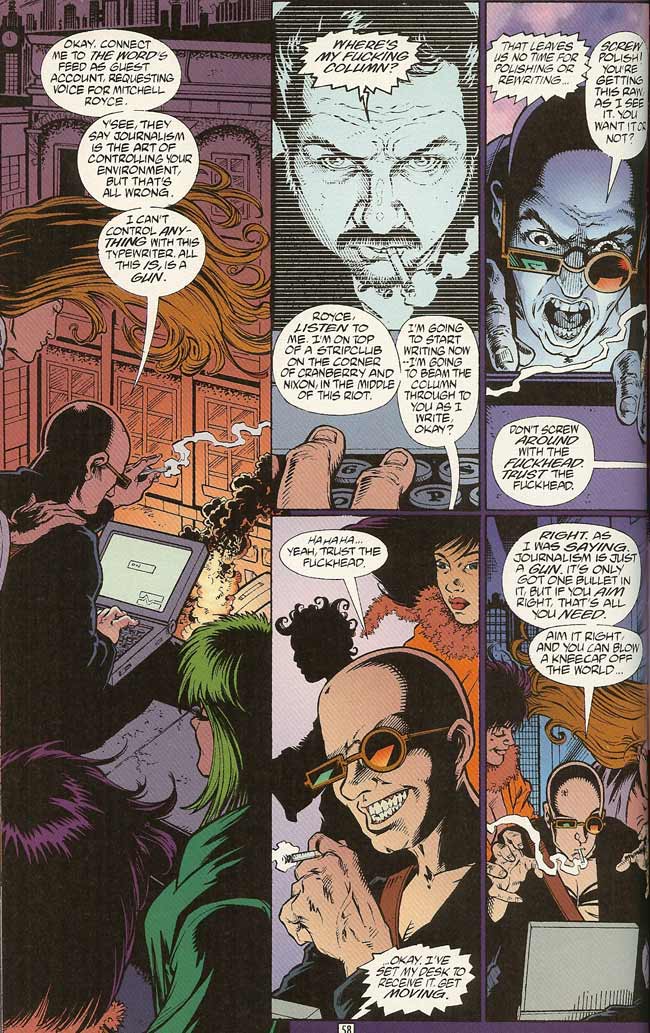
Overview: Ever since Blade Runner, the city has been the host for all that is seedy, slimy and scum ridden. But nobody does the cyberpunked city like Transmetropolitan, and nobody covers it like Spider Jerusalem. Jerusalem shows us the hyper-real – dregs of the dregs. Worse than you can imagine, the authorities shit all over the poor, downtrodden and destitute. And in this future, the poor aren’t just poor now, they’re transient, non-human, and sometimes shocked from being revived from a 200 year-old cryogenically frozen head and reinserted into a new body! Yes, this is the dystopian future, and up-close and nasty! No perversion is too big, and no secret is too nasty to uncover. Transmetropolitan was originally published as 60 different comic books, but is now only available in 10 Trade Paperbacks (TPBs), with one additional greatest hit TPB. You can get them on Amazon for around $10 bucks a piece, or sometimes may be able to get them cheaper from Ebay.
The Setting: In an unspecified distant dystopic future, America has become a place where there is the City, and then everything else. The City (no name is given or required) is a humongous massive sprawl, where every type of lowlife imaginable eaks out their miserable existence as best they can. Half the population in the city is doped up on all sorts of mild-altering, hallucinogenic drugs available. Body modifications are all the rage. Extra breasts, werewolf teeth, transplanting one’s mind into the body of a dog – nothing is too weird or forbidding. Many people called transients are slowly transforming themselves into aliens by injecting alien DNA to replace their own. Deviant religions abound – everything from religions celebrating pedophiles to continuous sex are intermixed with judgmental rants and insane prophecies. The rich and powerful live an idyllic existence in this new word order. Corporations and politicians both have the same goals – to fuck the population for their own benefits and gratification. Media feeds of all varieties abound in the Transmetropolitan future. The City is fully wired and monitored so that every happening can be recorded and played back for national amusement. Talk shows have even gotten more deviant than they already are today.
It is in this environment that Spider Jerusalem conducts his unique brand of journalism. While most of the newsmen of his time cower in the shadows and happily receive crap spewed from public liaison officers, Spider goes amongst the people to find the story. Early on, many of the mini-stories appear to be unrelated sub-plots, yet in the end, everything is connected.
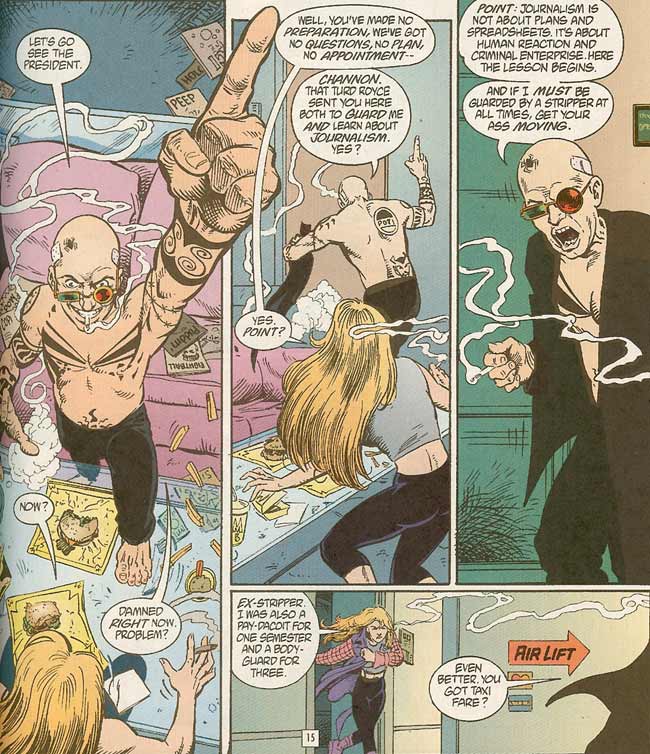
The Story: Infamous journalist, Spider Jerusalem, has been out of the game for five years, living in peace on his cabin in the mountains, when threats of lawsuits for unfinished work bring him back to the city. Spider has to write two books he’s already been paid for, but his money ran out long ago. To pay the bills, Spider gets a weekly column titled “I hate this city” at a daily newspaper called The Word, who pays his room and board. Spider starts covering the slime that is the city by all means available – news feeds, old contacts, and walking the worst neighborhoods to get up close and personal with the scum-ridden results of power gone awry. His columns bring down a corrupt president he calls the Beast, and then are targeted at torturing an even worse replacement Spider calls the Smiler. But more than that, they’re a vehicle for exploring this new, hyper-real society that Transmetropolitan brings us.
Spider Jerusalem: Spider Jerusalem is a Bastard. He chain smokes, pops every kind of drug he can find, masturbates constantly, pisses on anyone and anything, and has just about every kind of sickening human trait that humans can have. His weapon of choice is an illegal bowel disrupter, which causes people to immediately shit themselves into a stupor. Truly, Spider is the worst kind of bastard in that his pursuit of journalism is always the ultimate righteousness – the ultimate truth. No matter that thousands of people get wasted as a consequence of Jerusalem’s story.
The Truth Rules Everything: For Spider Jerusalem, the truth is all that matters. In Transmetropolitan, everyone and everything is a facade waiting to be uncovered. All politicians are not only crooked, they’re the worst that humanity has to offer. Everyone has an angle; a game they play that requires that they fuck up some poor underclass group in order to crawl to the top. And while exposing the truth is drives everything Jerusalem does, knowledge is transient. There are no truths of mankind in Transmetropolitan – the world as we know it has been deconstructed. All that’s left are the pieces.
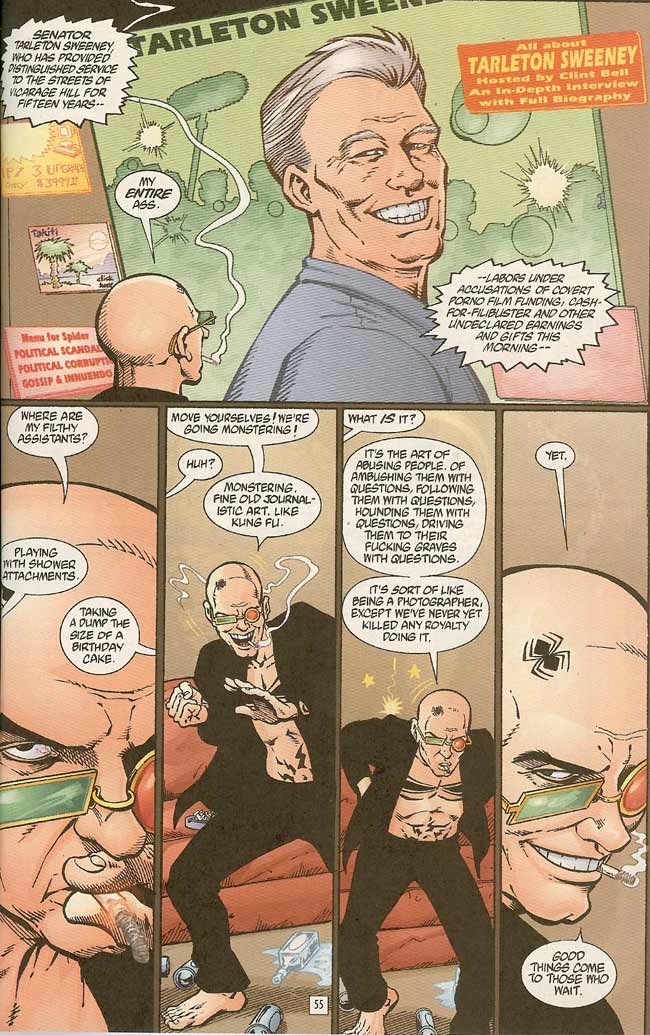
The Filthy Assistants: Spider has two assistants: Channon Yarrow and Yelena Rossini. Both of them develop a low-hate (mostly hate) relationship with Spider over the course of the series. Well, that’s not quite true – they start off hating him (REALLY hating him in Yelena’s case), and over time, they begin to understand him. Channon Yarrow eventually becomes his body guard while Yelena becomes his journalist assistant, but both evolve deliciously over the course of the series. Eventually, Spider, Yarrow and Yelena become an unstoppable trio.
The Writing & Artwork: Transmetropolitan is a terrific collaboration between two unassuming folks in the comic industry that succeeded in shooting for greatness. Warren Ellis, the writer of Transmetropolitan, does consistently brilliant work throughout the series. His dialogue is creative and always interesting (see the page scan above for an example). Spider Jerusalem clearly has a unique voice – one that creates mood all to its own. Additionally, the overall story arc is intricate, well written and wonderfully constructed. Flat out, Transmetropolitan provides us some of the best cyberpunk writing ever. Perfectly meshed with this story is Darick Robertson’s absolutely terrific down and dirty artwork. He seems to continually experiment in issue after issue - constantly trying new looks and different approaches while keeping the core intact. Far more often than not, this experimentation gives Transmetropolitan an almost constantly refreshed look.
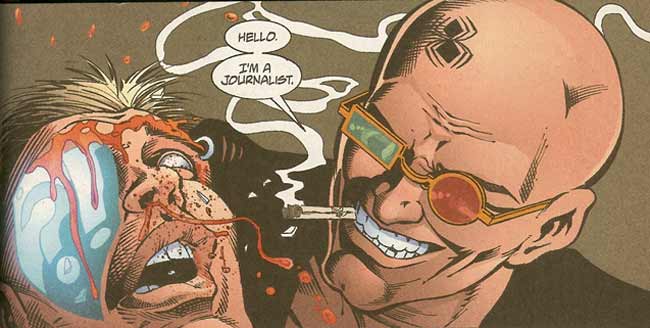
The Bottom Line: If you want to delve into one of the best graphic novels that cyberpunk has to offer, look no further than Transmetropolitan. The overall story is wonderfully constructed, and boasts extreme diversity in composition and approach while at the same time forming a coherent and satisfying whole. Once you start the first volume, you’ve have a hard time putting it down. By the time you read the second volume, you WILL be hooked for the rest of the series. As scary as these sounds, after reading just a few of their stories, you really will believe that the City is a real place. Sadly though, after you get familiar with Spider Jerusalem, you’ll notice yourself even more depressed than previously about the current state of our news media – they really don’t seem to be striving for the truth. In fact, they seem to be an integral part of the hypocritical bullshit that Spider is constantly exposing. If only Spider were real. 
Page 2: More Page Scans –>>
This post has been filed under Graphic Novels by SFAM.
Sometimes the US DVD distributors really piss me off. They unilaterally decide that dumb Americans like myself will only watch a movie if it’s spoken in God’s Language (Which is English, of course - this is verified by checking the earliest versions of the “real” bible - turns out it looks exactly like the King James version.  ). If a movie is from one of those foreign places (woe is them!) that haven’t agreed to speak God’s language yet, we must correct this flaw by providing a dubbed version prior to releasing it in God’s country. In one egregious case, Miramax, in their infinite wisdom, provided us this piece of shit: ). If a movie is from one of those foreign places (woe is them!) that haven’t agreed to speak God’s language yet, we must correct this flaw by providing a dubbed version prior to releasing it in God’s country. In one egregious case, Miramax, in their infinite wisdom, provided us this piece of shit:
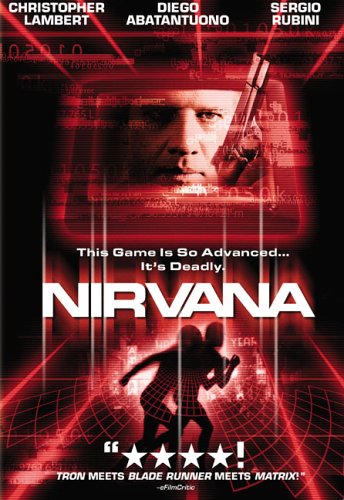
Based on this version, my earlier review of Nirvana started off like this:
All in all a decent cyberpunk flick from Italy, but unfortunately suffers horribly from bad dubbing. The dubbing here is as bad as your average anime dubbing, and unfortunately here in the US, this is all we get.  I wish I could get a copy of this in Italian with subtitles - if I did, I’m sure this would shoot up significantly on my cyberpunk list, but alas… I wish I could get a copy of this in Italian with subtitles - if I did, I’m sure this would shoot up significantly on my cyberpunk list, but alas…
Since then, based on a personal pleading at the bottom of my review, a number of you offered advice on how I could obtain a copy of the Italian version. Case provided me a link on XploitedCinema.com where I could buy the copy - something I eventually did, even though it set me back $30 bucks. Now my updated review of Nirvana reflects this copy:
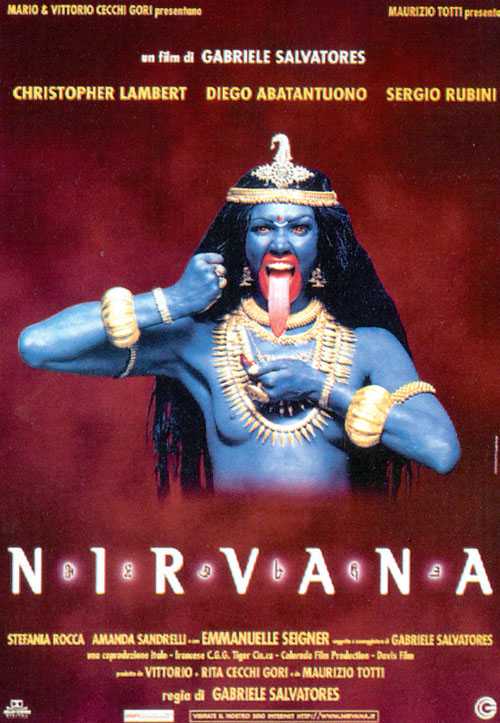
My rating bumped from 6 stars for the English dubbed version to 8 stars for the Italian language version. I must say though, I’m still pissed about having to drop another 30 bucks to get this - truly, the Italian sound track should have been included on the Region 1 disc (hence the ranting above - I really don’t hate religion, but do detest the arrogance in the US at times - this is one of those times). I don’t know that Nirvana is worth $30 bucks though - I rarely pay this much for a DVD. But if you’re planning on buying Nirvana, I would advise skipping the R1 version altogether, and instead save up for the Italian version. The dubbing on the R1 version is truly horrid - like low quality Japanese anime dubbing horrid.
This post has been filed under Site Development by SFAM.
Movie Review By: SFAM
Year: 2004
Directed by: Shinji Aramaki
Written by: Masamune Shirow (Manga), Haruka Handa & Tsutomu Kamishiro (screenplay)
IMDB Reference
Degree of Cyberpunk Visuals: Very High
Correlation to Cyberpunk Themes: Medium
Key Cast Members:
Deunan Knute: Ai Kobayashi
Briareos: Jûrôta Kosugi
Hitomi: Yuki Matsuoka

Overview: Masamune Shirow’s Appleseed recently got a second anime treatment. The last was in 1988 – this time, in 2004, the anime is done up in eye-popping 3D graphics. With a budget of only 10 million as compared to over 90 million for a movie like The Incredibles, we shouldn’t be expecting too much. Surprisingly, we get far more than expected, especially with regards to the wonderfuly rendered backgrounds. While the animation is interesting enough, the story is more problematic. So too are the change in the feel of the characters. This is really where the original version succeeds far better than Aramaki’s version.

The Story: Appleseed takes place in the year 2131, a war-ravaged dystopian future where most all of human society is in ruins. Over two years after the last war, the only example of advanced human civilization is a newly made city called Olympia, which has been engineered to be a created as a perfect refuge from the rest of the world. Over half of the city’s inhabitants are comprised of bio-engineered “biodroids,” which are human-like beings designed to serve specific roles in the society. An all-knowing computer named GIA supports the city council in controlling all aspects of city life.
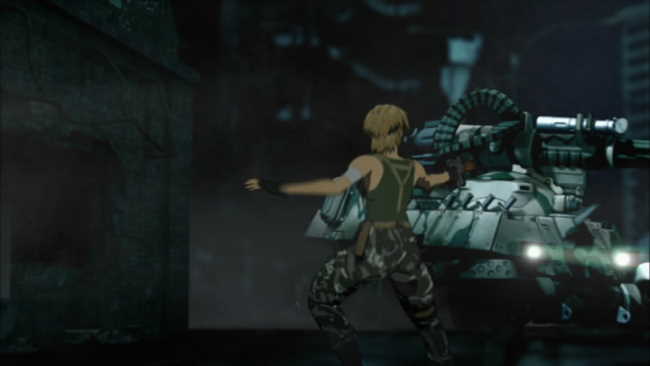
Deunan Knute, a fighter extraordinaire has been living alone in the wastelands, not realizing that the war is over. She is beset by two warring groups of fighters, one of which who is trying to kill her, and the other group, which rescues her and takes her to Olympia. There she is re-acquainted with her long lost lover, Briareos, who now has been transformed into a cyborg after his body was lost in the war. She is tasked to join “ESWAT,” a special mecha-enabled police force that keeps order within the city. Deunan also befriends a biodroid named Hitomi, who shows her around the city. Unfortunately, Deunan barely gets a chance to settle down before the assassination attempts on her life start.

Duenan quickly learns that she has been dropped in the middle of a power struggle between humans, who are concerned that the biodroids secretly aim to exterminate them, and biodroids, who worry the same about the humans. Somehow, Deunan has become essential in this struggle, yet it has nothing to do with her fighting capabilities. It turns out that her parents, before dying, developed a method for biodroids to reproduce, which would make them almost exactly like humans. But this research was lost long ago. Now, Deunan has become a pawn for both sides of this struggle, and worse, it appears as if her ex-lover, Briareos has chosen sides.
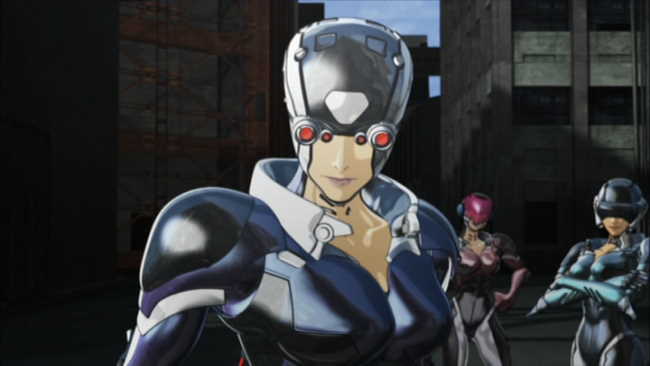
Unfortunately, the story in this version of Appleseed is problematic at best. There are too many sub-plots that obfuscate the key points. The myriad of loose ends introduced that are never followed up on. Gia, the sentient computer that runs Olympus is the probably the worst casualty. We get introduced to her, and, if you know something of the Appleseed story from the Manga, you expect to see lots more than what actually ends up being conveyed. In the end, the plot centers on a simple theme of racism. This is a shame as there were so many interesting cyberpunk aspects of Olympus that get short-circuited.
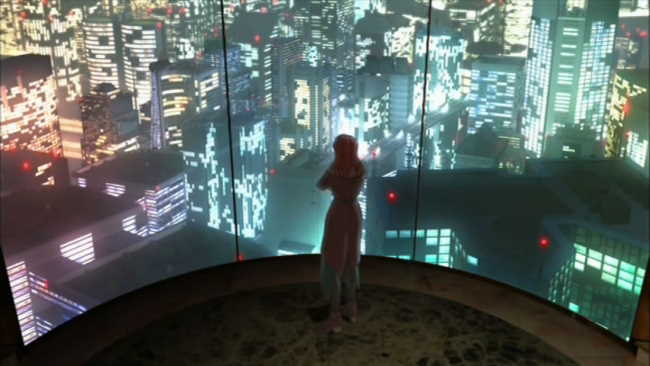
The Animation: Appleseed’s backgrounds are wonderfully rendered. This more than anything accounts for the majority of the “wows” Appleseed received. They are done in a way that allows 3D camera maneuvering, so as to allow you to see the same scene from multiple angles, and at times, even provides Matrix bullet-time effects. For the most part, the 3D CG overlaid with 2D cell shading really works. It’s an extension of the idea we saw in Malice@Doll, only with far better rendering tools. The machines look especially awesome. Both the Gunhed style tanks at the beginning of the movie and the platform sentinels at the end. Unlike many cyberpunk movies, there isn’t a dominating color palette in Appleseed, but the color scheme seems to stick more often than not to light and dark shades blue-greens, with yellow & browns in transition scenes.
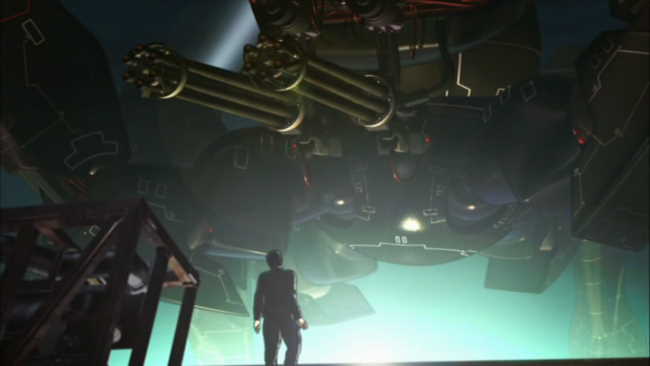
In terms of the characters, only Deunan Knute really looks polished. Her body movements, facial expressions and general actions really work. The rest, especially the human characters, often look stilted in their moments. Hitomi, their biodroid friend, is especially problematic at times. This might be due more to the motion-capture techniques they use, which work wonderfully for the city, but not so well for the characters. Also, I really dislike the way they animated the hair. The hair on the humans in the 2004 edition look like something out of Reboot. However, considering the budget, I think they made the right decision in spending scarce resources on Deunan. Had they just made everyone look slightly better, Appleseed would have faltered horribly. By at least making Deunan polished, they developed a star that fit right alongside their wonderful backgrounds.
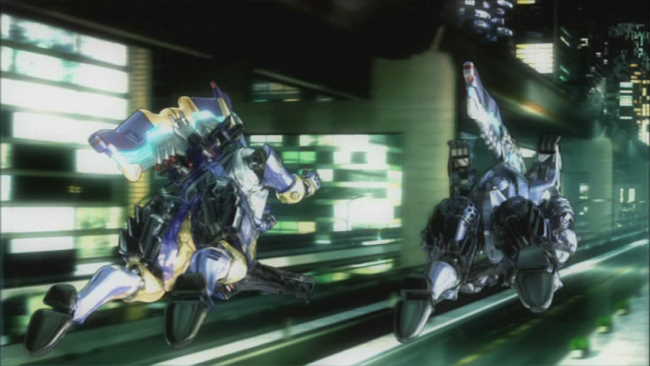
The Sound: Many times throughout the anime, Appleseed plays more like a music video than it does a movie. The modern heavy rock beats worked well for the action scenes. And truly, the action scenes are where Appleseed excels. There, the 3D positional sound, the music accompaniment and the 3D CG graphics are at their absolute best. The accompanying score really wasn’t all the memorable, but at least served up the slower paced moods fairly well.
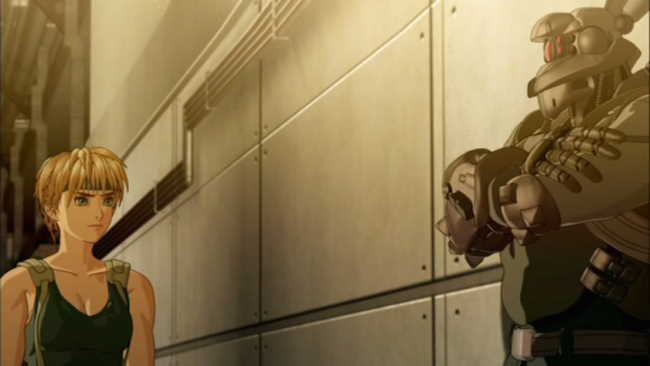
Differences From Shirow’s Work: While both animes deviate from Masamune Shirow’s Appleseed Manga, Aramaki’s version is the most egregious. While the 2004 version starts outside of Olympia as the Manga does, it only has Duenan there, whereas in the Manga has both. This version introduces a new dramatic twist of Duenan and Briareos getting back together for the first time in two years. While this in itself isn’t bad, the side-effect is: these two characters are no NOTHING like the Manga. The Duenan Knute and Briareos of Shirow’s Manga, and of the 1988 version, are precursors to the Ghost in the Shell’s Motoko and Batou. Here, Briareos is a moody, lost soul trying to deal with his cyborg body, and Duenan is far more vulnerable than tough. The playful chemistry we see between these two both in the Manga and the 1988 anime is completely missing here. For those who aren’t familiar with the Manga, this probably won’t bug you, but it certainly sapped some of the enjoyment out of this movie for me – so much so that I’m dropping a star off the review for it.

The Bottom Line: Appleseed is definitely worth seeing for the visuals alone. While some of the characters don’t work, the Duenan, the machines and the action scenes work wonderfully. Unfortunately, the story doesn’t equal up. Too many elements are introduced and then discarded in favor of a truly simplistic storyline. They could have done better. Also, as I mention above, this is not the Deunan and Briareos I’ve become familiar with – these characters are different from both the Manga and the earlier anime. This bugged me enough to drop a star from the review, but you might not mind so much.
Page 2: More Screencaps –>>
~See movies similar to this one~
WordPress database error: [You have an error in your SQL syntax; check the manual that corresponds to your MySQL server version for the right syntax to use near '' at line 1]
SELECT COUNT(ID) FROM
|
















































